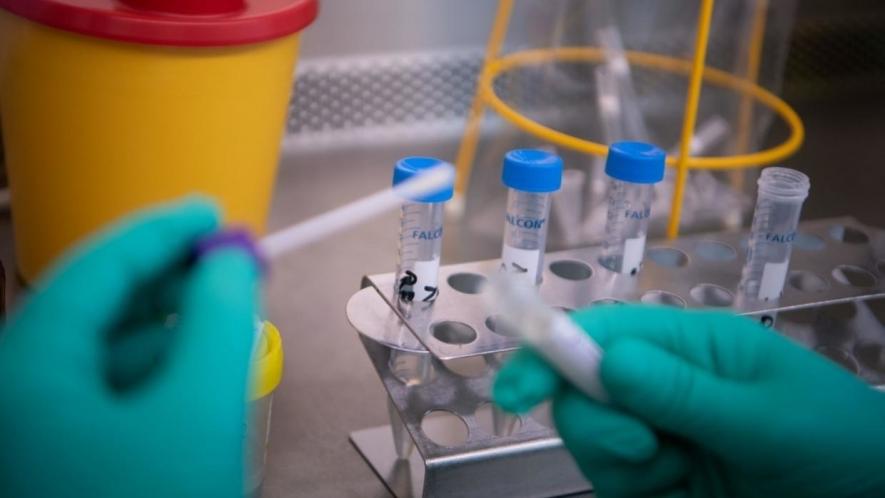COVID-19: ‘Probability of Continued Transmission in India Remains Very High’

New Delhi: The way the COVID-19 outbreak has unfolded in a couple of weeks in Europe, especially in Italy and Spain, where the healthcare system is supposed to be good, the threat of a spike in cases looms large over India, unless testing is done on a war-footing.
“Although, the spread so far in India is slow and infected cases are minimum, as per reports, this could be because India is not testing enough people considering its large population,” Dr Mumtaz Naiyer, Senior Research Associate, Department of Pathology, University of Cambridge, the United Kingdom.
In an e-mail interview with Newsclick, Dr Naiyer said earlier, some scientists believed that as the temperature goes higher in March and April, the virus may not survive for long. “However, the strain of SARS-CoV-2 that is circulating can survive higher temperature, and if this becomes true, then this is not good news for India,” he said.
Citing the case of Europe, Naiyer said the “overall 14-day cumulative incidence rate for the EU/EEA and the UK has increased from 3.3 cases per 100 000 population on March 11 to 36.1 cases per 100, 000 population on March 25, 2020, although we have seen rise in temperature in the Europe and the UK.”
Raising a red flag over the possibility of a spike in cases in India in a few weeks, the doctor said: “There is a growing number of cases in many countries without epidemiological links to explain the source of transmission. Based on the predicted development of the 14-day cumulative notification rate, similar levels to those seen in Hubei province are expected to be seen in India a few days to a few weeks. Although uncertainty remains about the extent to which the prevention and control measures introduced will slow the speed of transmission, the probability of further continued transmission in India remains very high.”
Naiyer, however, applauded the 21-day lockdown in India but said it was not implemented the way it should have been as many people were stranded in cities and could be potential carriers.
“There are vulnerable groups and the Indian government should address those problems,” he added.
On India’s preparedness, Naiyer said it varied from state to state. “Poor states like Bihar may face unprecedented problems in containing COVID-19 because of poor health and medical infrastructure. However, a state like Kerala did a wonderful job although it was the first state to report COVID-19 cases,” he said.
He said quarantine facilities in India were not up to the standard. “The chances of secondary infections are extremely high in those quarantine facilities,” he added.
Expressing grave concern over the situation in the coming days, Naiyer said: “If its progression remains on its current course, without strong counter-measures and surge capacity enacted, there is a high probability that India will experience demands that far exceed the currently available ICU capacity.”
Furthermore, he said the healthcare staff in India was under pressure and resources were strained across different states.
“Keeping in mind India’s 1.3 billion population, the Indian government has allotted a minuscule amount of budget for tackling the pandemic as compared to the UK, the Europe and the US,” he said.
The doctor said the emergence of severe acute respiratory syndrome coronavirus 2 (SARS-CoV-2; previously provisionally named 2019 novel coronavirus or 2019-nCoV) disease (COVID-19) in China at the end of 2019 was a major public health issue.
“SARS- CoV-2 was found to be a positive-sense, single-stranded RNA virus belonging to the genus betacoronavirus. Phylogenetic analysis revealed that SARS-CoV-2 is closely related (88–89% similarity) to two bat-derived SARS-like coronaviruses, namely bat-SL-CoVZC45, but it is more distant from SARS-CoV (79% similarity) and Middle East respiratory syndrome coronavirus (MERS-CoV), with 50% similarity. Its entire genome was 29 881 bp in length (confirmed by sequencing). Phylogenetic analysis indicates that SARS-CoV-2 is similar to the coronavirus circulating in Rhinolophus (horseshoe bats), with 98.7% nucleotide similarity to the gene of the bat coronavirus strain BtCoV/4991 and 87.9% nucleotide similarity to bat coronavirus strain bat-SL-CoVZC45 and bat-SL-CoVZXC21. In addition to seasonal influenza, these viruses can cause co-infection in the setting of community- acquired bacterial pneumonia,” he explained.
Get the latest reports & analysis with people's perspective on Protests, movements & deep analytical videos, discussions of the current affairs in your Telegram app. Subscribe to NewsClick's Telegram channel & get Real-Time updates on stories, as they get published on our website.
























